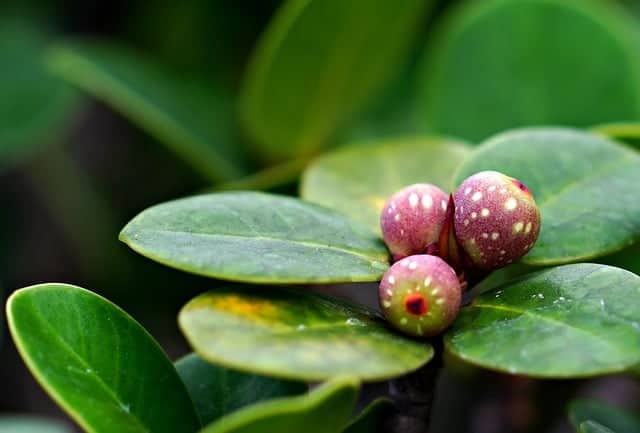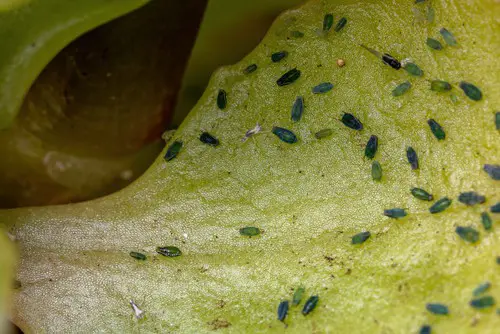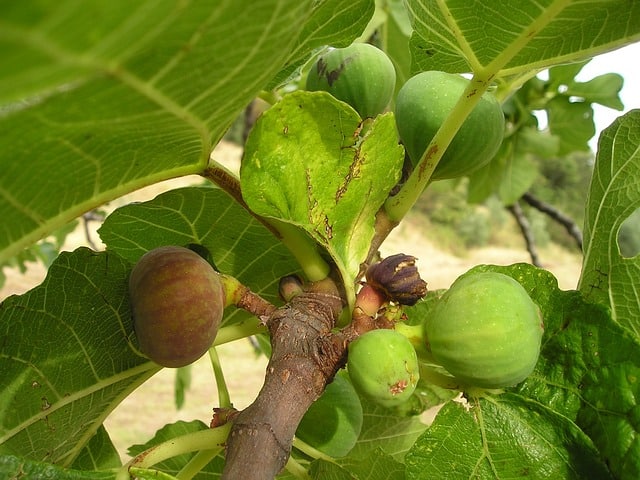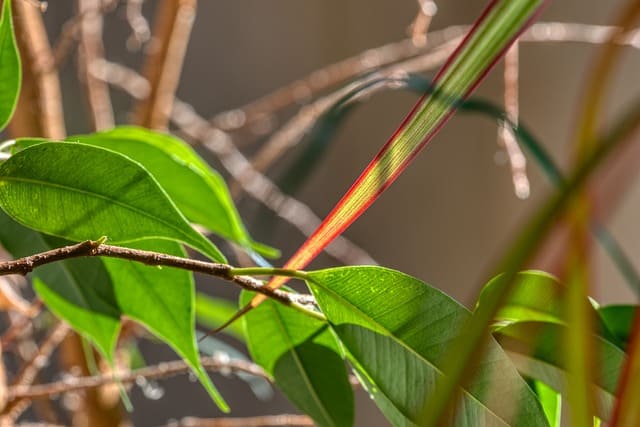Ficus plants are a popular choice for indoor and outdoor gardening due to their attractive foliage and ease of care. However, one common issue that ficus owners face is the appearance of black spots on the leaves of their plants. These spots can be unsightly and may indicate an underlying problem that needs to be addressed.
Identifying the cause of black spots on ficus leaves is crucial in determining the appropriate course of action for treatment. There are several common causes of black spots, including fungal and bacterial infections, environmental stress, and pest infestations.
Symptoms of black spots on ficus leaves may include discoloration, leaf drop, and stunted growth. Proper diagnosis and treatment are essential to prevent further damage to the plant.
Key Takeaways
- Black spots on ficus leaves can indicate an underlying problem that needs to be addressed.
- Causes of black spots include fungal and bacterial infections, environmental stress, and pest infestations.
- Proper diagnosis and treatment are essential to prevent further damage to the plant.
Also see:
Identifying Black Spots on Ficus Leaves

Black spots on ficus leaves can be caused by a variety of factors, including overwatering, fungal infections, and bacterial infections. Identifying the cause of the black spots is important to determine the appropriate treatment.
One way to identify the cause of black spots on ficus leaves is to examine the leaves closely. If the black spots are accompanied by yellowing or browning of the leaves, it may be a sign of overwatering. Overwatering can cause root rot, which can lead to fungal infections.
If the black spots are circular and have a distinct border, it may be a sign of a fungal infection. Fungal infections can be caused by a variety of factors, including overwatering, poor drainage, and high humidity. Fungal infections can be treated with fungicides, but it is important to identify the specific type of fungus in order to choose the appropriate treatment.
If the black spots are angular and limited in size by veins, it may be a sign of a bacterial infection. Bacterial infections can be caused by poor sanitation practices or contaminated soil. Bacterial infections can be treated with antibiotics, but it is important to identify the specific type of bacteria in order to choose the appropriate treatment.
In some cases, black spots on ficus leaves may be caused by environmental factors such as exposure to cold or hot temperatures, or exposure to chemicals or pollutants. It is important to rule out these factors before treating the plant for a fungal or bacterial infection.
Black Spots on Ficus Leaves – 4 Common Problems
Ficus trees are popular indoor plants that can add a touch of greenery to any space. However, they are susceptible to various problems, including black spots on their leaves. Here are some common causes of black spots on ficus leaves:
1. Fungal Infections
Fungal infections are one of the most common causes of black spots on ficus leaves. The most common fungus that causes black spots is Cercospora fungus. This fungus thrives in warm and humid conditions. It causes dark spots to appear on the leaves, which can eventually lead to leaf drop.
2. Bacterial Infections
Bacterial infections can also cause black spots on ficus leaves. The most common bacteria that causes black spots is Xanthomonas campestris. This bacterium thrives in high humidity and can cause black spots on the leaves.
3. Pest Infestations

Pest infestations can also cause black spots on ficus leaves. Spider mites and mealybugs are the most common pests that can cause black spots. These pests feed on the leaves, causing damage that can lead to black spots.
4. Environmental Factors
Environmental factors can also cause black spots on ficus leaves. Low humidity, cold temperatures, and drafts can all cause stress to the plant, leading to black spots. Overwatering or underwatering can also cause stress to the plant, leading to black spots.
Symptoms of Black Spots on Ficus Leaves
Ficus trees are popular indoor plants known for their attractive glossy leaves. However, black spots on the leaves can indicate a problem with the plant. In this section, we will discuss the symptoms of black spots on ficus leaves.
1. Leaf Drop
One of the most common symptoms of black spots on ficus leaves is leaf drop. Ficus trees are sensitive to changes in their environment, and stress can cause them to drop their leaves.
Overwatering, underwatering, and exposure to extreme temperatures can all cause stress and lead to leaf drop. Black spots on the leaves can also be a sign of fungal or bacterial infections, which can cause the leaves to drop.
2. Yellowing
Yellowing of the leaves is another symptom of black spots on ficus leaves. This can be caused by a lack of nutrients, overwatering, or exposure to extreme temperatures. Black spots on the leaves can also be a sign of fungal or bacterial infections, which can cause the leaves to yellow.
3. Brown Spots

Brown spots on ficus leaves can indicate a fungal or bacterial infection. These spots are typically circular and can vary in size. In severe cases, the leaves may turn yellow and fall off. Brown spots can also be caused by overwatering, underwatering, or exposure to extreme temperatures.
4. Branch Dieback
Branch dieback is a more severe symptom of black spots on ficus leaves. This occurs when the branches of the plant begin to die and turn black. Branch dieback can be caused by fungal or bacterial infections, as well as stress from overwatering, underwatering, or exposure to extreme temperatures.
Diagnosis and Treatment of Black Spots
Ficus plants are known for their attractive foliage, but black spots on the leaves can be a sign of a problem. To diagnose and treat black spots on Ficus leaves, it’s important to understand the underlying causes. This section will cover different treatments and adjustments that can help.
1. Fungicides and Bactericides
Black spots on Ficus leaves can be caused by fungal or bacterial infections. Fungal leaf spots are usually caused by Cercospora fungi, which appear as small black dots on the leaves. Bacterial leaf spot is caused by Xanthomonas campestris, and it can cause angular yellow spots on the leaves that turn brown and fall off.
To treat fungal or bacterial infections, it’s important to use the right fungicides or bactericides. One effective fungicide is copper-based fungicide, which can be sprayed on the leaves to kill the fungus.
Bactericides like streptomycin can be used to treat bacterial infections. It’s important to follow the instructions on the product label carefully and use the recommended amount of fungicide or bactericide.
2. Pest Control
Black spots on Ficus leaves can also be caused by pests like mealybugs, scale insects, and thrips. These pests can feed on the leaves, causing damage that leads to black spots. To control pests, it’s important to use the right insecticides.
Neem oil is a natural insecticide that can be effective against many pests. Rubbing alcohol can also be used to kill pests like mealybugs and scale insects.
It’s important to follow the instructions on the product label carefully and use the recommended amount of insecticide. In some cases, it may be necessary to remove heavily infested leaves or plants to prevent the spread of pests.
3. Environmental Adjustments

Black spots on Ficus leaves can also be caused by environmental factors like excess water or poor air circulation. Overwatering can lead to root rot, which can cause black spots on the leaves. To prevent overwatering, it’s important to let the soil dry out between waterings and ensure that the pot has good drainage.
Poor air circulation can also lead to black spots on Ficus leaves. To improve air circulation, it’s important to place the plant in a well-ventilated area or use a fan to circulate air around the plant.
Preventive Measures for Black Spots
Ficus trees are prone to black spots on their leaves due to various reasons such as overwatering, fungal growth, and nutrient deficiency. However, there are several preventive measures that can be taken to avoid black spots on ficus leaves.
1. Proper Watering and Drainage
One of the primary reasons for black spots on ficus leaves is overwatering. It is essential to water the ficus plant only when the top layer of soil is dry to the touch. Overwatering can lead to root rot, fungal growth, and eventually black spots on the leaves. Ensure that the pot has proper drainage holes to prevent water from accumulating at the bottom of the pot.
2. Adequate Sunlight
Ficus trees require adequate sunlight to thrive and maintain their health. Lack of sunlight can lead to weak growth and make the plant more susceptible to diseases such as black spots. Ensure that the ficus plant receives at least six hours of direct sunlight every day.
3. Regular Pruning
Regular pruning of the ficus plant helps to maintain its shape and size. It also helps to remove any diseased or damaged leaves and branches, which can lead to the spread of diseases such as black spots. Prune the ficus plant during the growing season to promote healthy growth.
4. Nutrient Supply
Ficus trees require a balanced supply of nutrients to maintain their health and prevent diseases. Ensure that the ficus plant receives a balanced supply of nutrients such as nitrogen, phosphorus, and potassium. Use a balanced fertilizer specifically designed for ficus plants.
Common Types of Ficus and Their Susceptibility to Black Spots

Ficus plants are a popular choice for houseplants due to their attractive foliage and ease of care. However, these plants are susceptible to a number of diseases, including black spots on the leaves. The severity of the disease can vary depending on the type of ficus plant. Here are some common types of ficus and their susceptibility to black spots.
Ficus Benjamina
Ficus benjamina, also known as the weeping fig, is one of the most popular indoor trees. It is native to Southeast Asia and is prized for its glossy, dark green leaves. Unfortunately, this plant is also highly susceptible to black spots on its leaves.
The spots are caused by fungal infections such as anthracnose and leaf spot. These diseases can cause the leaves to curl up and drop off the plant.
Ficus Elastica
Ficus elastica, also known as the rubber plant, is another popular ficus plant. It is native to India and is prized for its large, glossy leaves.
This plant is less susceptible to black spots than Ficus benjamina, but it can still be affected by fungal infections such as leaf spot. The disease can cause small brown or black spots on the leaves that can grow larger over time.
Ficus Lyrata
Ficus lyrata, also known as the fiddle-leaf fig, is a popular houseplant due to its large, violin-shaped leaves. It is native to West Africa and is prized for its unique appearance.
This plant is less susceptible to black spots than Ficus benjamina, but it can still be affected by fungal infections such as leaf spot. The disease can cause small brown or black spots on the leaves that can grow larger over time.
Overall, ficus plants are susceptible to black spots on their leaves, and the severity of the disease can vary depending on the type of plant. It is important to monitor your ficus plants for signs of disease and take steps to prevent and treat infections.
Frequently Asked Questions

How can I identify and treat black spots on my Ficus leaves?
To identify black spots on Ficus leaves, look for small, circular spots that are dark in color and may be slightly raised. If you notice these spots on your plant, it is important to treat them as soon as possible to prevent further damage.
One effective treatment is to remove the affected leaves and dispose of them in the trash. You can also use a fungicide treatment to help prevent the spread of the disease.
What causes black spots to appear on Ficus leaves?
There are several possible causes of black spots on Ficus leaves, including overwatering, bacterial or fungal infections, and cold injury. Overwatering can lead to root rot and fungal growth, which can cause black spots to appear on the leaves.
Bacterial and fungal infections can also cause black spots to form on the leaves. Cold injury can cause brown blotches on older leaves and distort younger leaves.
Are black spots on Ficus leaves a sign of disease?
Yes, black spots on Ficus leaves are often a sign of disease. Bacterial and fungal infections can cause black spots to form on the leaves. Overwatering can also lead to fungal growth and black spots on the leaves.
What are some effective treatments for leaf spots on Ficus?
Effective treatments for leaf spots on Ficus include removing the affected leaves and disposing of them in the trash. You can also use a fungicide treatment to help prevent the spread of the disease. It is important to follow the instructions on the fungicide carefully to avoid overuse of the chemical.
How do I prevent black spots from forming on my Ficus leaves?
To prevent black spots from forming on your Ficus leaves, make sure to water the plant appropriately and avoid overwatering. Keep your plant away from cold drafts or spaces that are prone to sudden temperature drops. You can also use a fungicide treatment to help prevent the spread of disease.
Can bacterial or fungal infections cause black spots on Ficus leaves?
Yes, bacterial or fungal infections can cause black spots to form on Ficus leaves. Bacterial leaf spot and cercospora leaf spot are two common fungal infections that can cause black spots to appear on the leaves.

Hey, I’m Lisa and I’ve been an avid gardener for over 30 years. I love writing, talking and living in the garden! Feel free to connect with me on my socials below

